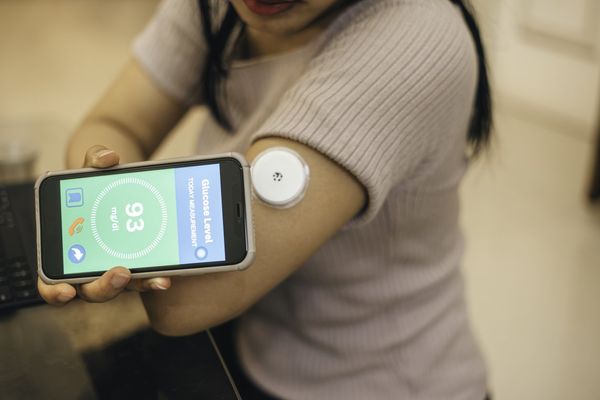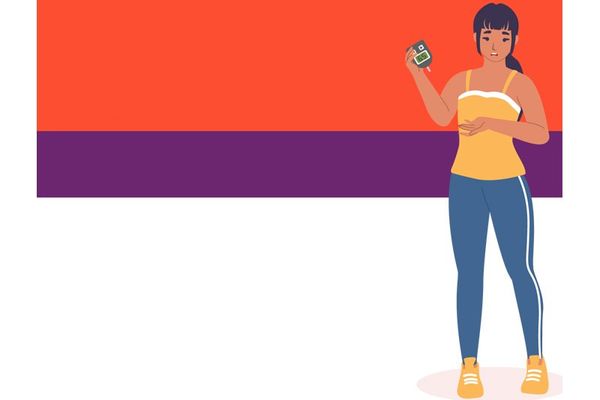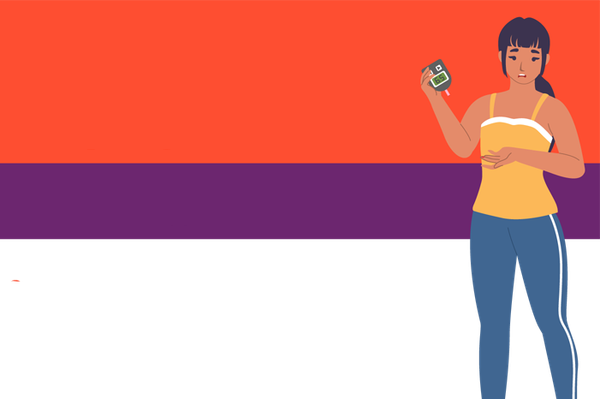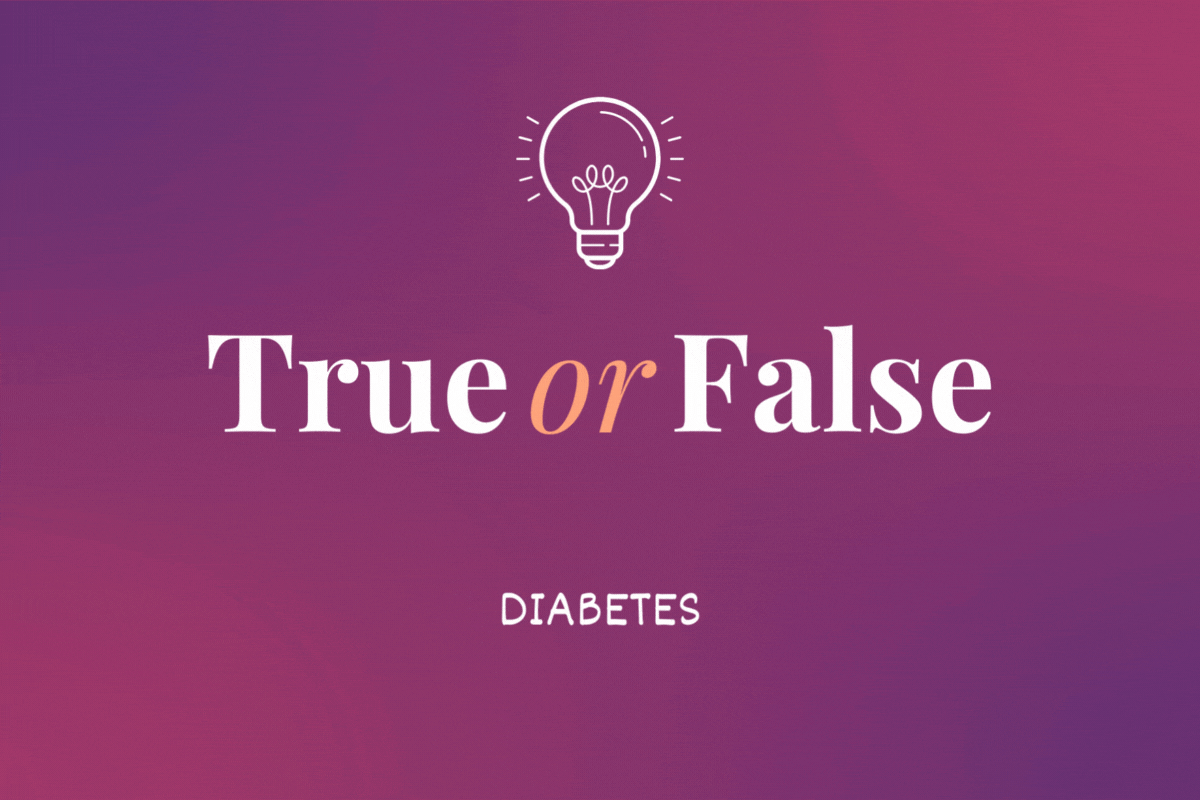Developing a chronic disease is not your fault, although many women who develop type 2 diabetes may feel this way, especially when obesity is an issue. If you are diagnosed with diabetes, it is essential that you receive comprehensive information—whether from a primary health care professional, certified diabetes educator or endocrinologist—on how to manage your condition and avoid complications.
Many people with diabetes don't have access to the help they need to adequately manage their condition. In addition, learning diabetes management skills takes time. People with diabetes need to regularly review and revise their strategies for managing their disease, under the guidance of their health care professionals.
Women with diabetes should be seen regularly by a health care professional who monitors their diabetes and checks for complications. Health care professionals who specialize in diabetes are called endocrinologists or diabetologists. In addition, people with diabetes often see ophthalmologists for eye examinations, podiatrists for routine foot care, registered dietitians for help in planning meals and diabetes educators for instruction in day-to-day care.
The goal of diabetes management is to keep blood glucose levels as close to normal as possible (without causing adverse consequences, such as hypoglycemia) to prevent complications associated with the condition. One government study proved that keeping blood sugar levels close to normal reduces the risk of developing major complications of diabetes. The National Diabetes Education Program urges people with diabetes to control not only their blood glucose, but also their blood pressure and cholesterol. This comprehensive management of diabetes is crucial to helping prevent heart attack and stroke.
Living with diabetes can be overwhelming at times. Like all chronic diseases, it affects every aspect of your daily routine. Diabetes management is not as simple as just taking a pill. It requires timing of meals, checking blood sugar and being vigilant about exercise, all in accordance with a personalized management plan developed in consultation with health care professionals.
Managing What You Eat
Your blood sugar can stabilize or skyrocket, depending on what you eat. Food is a mixture of fats, proteins and carbohydrates. All three are necessary parts of a healthy eating plan, but people with diabetes need to be most concerned about carbohydrates.
Carbohydrates in food end up as sugar (glucose) when they are absorbed into the bloodstream. The more carbohydrates you eat, the higher your blood sugar level. Although all carbohydrates raise blood sugar, different foods have different effects, depending on the type of food, which foods your carbohydrates are eaten with and how the food is prepared.
Raw foods, for example, are digested more slowly than cooked foods. Foods that are broken down more slowly release glucose into the blood more slowly. Foods that contain fat also take longer to digest than foods without fat. That's why an ice cream cone or a chocolate bar may not cause blood sugar levels to rise as quickly as you might expect. Checking your blood sugar two hours after eating carbohydrates is the best way to learn the effects of different foods.
Moderation is key. At one time, people with diabetes were told not to eat sweets at all. Today, sweets and snacks are allowed, but portions need to be small and balanced during the day.
Unlike carbohydrates, fats do not raise blood sugar levels but fatty foods increase insulin resistance and do add pounds. Plus, a high-fat diet increases your risk for heart disease.
Cutting back on dietary fat, which contributes to high cholesterol levels, is important for people with diabetes because they are already at higher risk for heart disease. Women on low-fat diets should be aware that some low-fat and nonfat foods contain considerably more carbohydrates than the full-fat versions.
For women with type 1 diabetes, who must take insulin daily, balancing food intake with insulin and exercise is essential to prevent high blood sugar (called hyperglycemia) or low blood sugar (called hypoglycemia) in which blood sugar levels dip below 70 mg/dl.
Hypoglycemia can occur suddenly. Early indicators of low blood levels include: shakiness and sweating, dizziness, pounding heart, weakness, hunger and confusion. Both hyperglycemia and hypoglycemia can be life threatening.
To determine how much insulin is needed to prevent blood sugar problems, it is important to know how meals and snacks influence blood sugar levels. Generally, the more carbohydrates you eat, the more insulin you need; the fewer carbohydrates you eat, the less insulin you need. Still, only by checking blood sugar two to three hours after eating can you know the effect of different kinds and amounts of food.
The American Diabetes Association recommends limiting saturated fat intake to less than 7 percent of total daily calories and minimizing intake of trans fat. In addition, the ADA recommends monitoring carbohydrates through carbohydrate counting, exchanges or estimation based on experience. It suggests that the glycemic index and glycemic load, which rank foods based on how they affect blood sugar, may also help people with diabetes control blood sugar levels.
The American Diabetes Association provides the Diabetes Food Pyramid, which divides foods into the following six groups:
- Grains and starches: six to 11 servings per day
- Vegetables: three to five servings per day
- Fruit: two to four servings per day
- Milk and dairy: two to three servings per day
- Meat and meat substitutes: four to six servings per day
- Fats, sweets and alcohol: keep servings small and save for a special treat
In addition, the American Diabetes Association offers the following tips:
- Eat lots of non-starchy vegetables and pick from a rainbow of colors to maximize variety. Choose vegetables such as spinach, carrots, broccoli or green beans with meals.
- Choose whole, frozen or canned fruit in water or its own juice instead of juices or sweetened canned fruit.
- Choose whole-grain foods, like brown rice or whole-wheat spaghetti, over processed grain products.
- Include dried beans (like kidney or pinto beans) and lentils in your meals.
- Eat fish two to three times per week.
- Choose lean meats like cuts of beef and pork that end in "loin," such as pork loin and sirloin. Remove the skin from chicken and turkey.
- Choose nonfat dairy products, such as skim milk, nonfat yogurt and nonfat cheese.
- Drink water and calorie-free "diet" drinks instead of regular soda, fruit punch, sweet tea and other sugar-sweetened drinks.
- Cook with liquid oils instead of solid fats that can be high in saturated and trans fats. And if you're trying to lose weight, watch your portion sizes of added fats.
- Account for carbohydrate content from all nutritive sweeteners (sucrose, fructose, corn syrup, fruit juice, honey, molasses, dextrose, maltose, sorbitol, mannitol and xylitol). They can affect blood glucose levels.
- Sodium: People differ in their sensitivity to sodium and its effect on blood pressure. Limit your intake to 2,300 mg per day. Because it is impractical to assess how sensitive you are to sodium, sodium recommendations for people with diabetes are the same as those for the general population.
- Vitamins and mineral supplements: Talk to your health care professional about whether you need to take a daily multivitamin. Research indicates that the best approach is to eat a balanced daily diet, with plenty of fruits, vegetables and whole-grain carbohydrates.
For more information on nutrition and diabetes, check out https://www.diabetes.org/healthy-living/recipes-nutrition/eating-well.
Weight Management and Exercise
More than 85 percent of people newly diagnosed with prediabetes or type 2 diabetes are overweight, making weight management very important.
Although we still don't know why, being overweight makes you less responsive to insulin, while losing weight has the opposite effect. You don't have to lose a lot of weight to see an improvement. Even losing 7 percent to 10 percent of your body weight helps. The focus for women with diabetes, however, should be on improving blood glucose levels—not on the scale.
Exercise is another cornerstone of any diabetes treatment plan. Besides burning calories and promoting weight loss, exercise reduces blood sugar levels and makes cells more sensitive to insulin, allowing some people with diabetes to use less medication.
Exercise has psychological benefits too. People who exercise are generally more aware of their bodies and the factors that affect their blood sugar. They often have a more positive outlook and are better able to manage their condition. Improved self-focus, self-esteem and positive outlook may be especially important for women.
Regular exercise is an essential part of managing type 1 diabetes, too, but management of blood sugar during exercise can be complicated. Those with type 1 diabetes have to adjust their food or insulin to keep their blood sugar from getting too high or too low. A vigorous workout, for example, can increase the amount of glucose the liver releases into the bloodstream, causing blood sugar levels to rise, especially right after exercising. Strenuous exercise can push high blood sugar levels even higher if there isn't enough circulating insulin available, leading to a life-threatening condition called diabetic ketoacidosis. Or, if blood sugar levels are low when exercise starts or if exercise is prolonged, low blood sugar or hypoglycemia can result.
Women with type 2 diabetes may also have low blood sugar after exercise, especially those using oral medications or insulin. Low blood sugar can last for hours as the muscles use glucose from the blood to replenish that used during a workout.
Thus, it's important to know and heed the signs of low blood sugar and be prepared to adjust meals or medication to keep sugar levels from plummeting. You need to check blood sugar levels before, during and after exercise to see what affect your workout has. No two people with diabetes will have the same response to exercise.
Before starting an exercise program, check with your health care professional. Exercise is a two-sided coin. It is the most important thing you can do to improve blood sugar and prevent diabetes complications, but the wrong type of exercise can make diabetes-related problems worse. Bouncing can aggravate diabetic eye disease, for example. Exercises that strain the upper body or require heavy lifting can raise blood pressure. Activities such as running and high-impact aerobics may be too hard on the feet and legs if you have any nerve damage.
To avoid injury, start slowly and don't overdo the intensity. Be sure to include a warm-up and cool-down phase. And understand that the effect of exercise on insulin resistance is short-lived. You have to stay with it to see improvement.
Exercise doesn't have to be sports-oriented or vigorous, however. It can be recreational, such as gardening, hiking, swimming or dancing. Brisk walking is one of the best things to do. Aim for at least 30 minutes of exercise a day, at least five days a week. If you're trying to lose weight, you may want to exercise more than 30 minutes a day.
These guidelines can help keep exercise safe and healthy:
- Ask your health care professional what blood sugar and heart rate guidelines to aim for before, during and after exercise.
- Do different activities, such as walking, biking and swimming, to stay motivated and to lessen the chance of injury.
- Carry medical ID and never exercise alone.
- Keep a log to track blood sugar response to different types of exercise.
- Keep a source of concentrated carbohydrate like a sports drink or raisins available in case blood sugar levels drop.
- Check your feet for blisters, bunions and calluses.
- Wear pool shoes in the pool to avoid scraping the soles of your feet.
- Don't exercise in extreme temperatures.
- Don't exercise if you have untreated eye problems such as blurred vision.
- If you have heart disease or high blood pressure, avoid exercises such as pushing against a wall or lifting and holding heavy weights, that involve keeping your muscles contracted.
Medical Treatments
Along with lifestyle modifications, medical treatment is essential to the management of type 1 diabetes. While not a cure, insulin is the most powerful glucose-lowering agent available. Insulin therapies administered two times or more per day through injections or pump therapy can stabilize and manage the disease, helping delay or avoid complications.
Most insulin is still primarily administered as an injection, using a small short needle. At this point, insulin can't be delivered in a pill, because it is a protein; that means your body would break it down and digest it before it could get into your bloodstream. However, investigators are exploring ways of making insulin easier to take, including insulin pills with a special coating or altered structure to get it through the stomach (not much research has been done on insulin pills at this point, though), skin patches, insulin that is delivered as a spray into the back of the mouth and inhaler devices.
Insulin devices have become more convenient in recent years. Insulin pens, for example, can be helpful if you take at least three doses of insulin a day and want to carry insulin with you. An insulin pen looks like a pen with a cartridge that holds 150 or 300 units of insulin. A fine, short needle, similar to the needle on an insulin syringe, is on the tip of the pen. You turn a dial to select the desired dose of insulin and press a plunger on the end to deliver the insulin just under the skin.
The FDA has also approved insulin jet injectors, which look like large pens and send a fine spray of insulin through the skin by a high-pressure air mechanism. Insulin jet injectors are costly and have other downsides so they are not widely used. If you plan to purchase one, try out several models before you buy.
There are several types of insulin with varying speeds of action. They range from rapid-acting, which begins working within 15 minutes after injection, to very long-acting, which works evenly for up to 24 hours. Many people with insulin-dependent diabetes take two types of insulin. How quickly or slowly insulin works in your body depends on your own response, where on your body you inject insulin, the type and amount of exercise you do and the length of time between your shot and exercise.
If you have type 2 diabetes, you may be able to manage your blood sugar with lifestyle or oral medications as long as your pancreas continues to make insulin. . However, because diabetes is a progressive disease, most people eventually need medication to help their body better use insulin, and some eventually require insulin.
Medications used to manage type 2 diabetes can be divided into two groups: those that augment your own supply of insulin and those that make your own insulin more effective.
Insulin-Augmenting Agents
- Sulfonylureas stimulate the beta cells of your pancreas to secrete more insulin. Examples include: glyburide, glimepiride (Amaryl) and extended-release glipizide (Glucotrol XL).
- Meglitinides also stimulate your pancreas to make more insulin, but have a shorter onset of action and shorter half-life than the sulfonylureas. The drug in this class is repaglinide (Prandin).
- D-phenylalanine derivatives help the pancreas produce insulin earlier after a meal and release the insulin for a shorter time compared to sulphonylureas. This helps lower your blood glucose after you eat a meal and is less likely to cause low sugars several hours after the meal. Nateglinide (Starlix), which is also known as a meglitinide, currently is the only medicine in this relatively new group of diabetes pills.
- DPP-4 inhibitors (Dipeptidyl peptidase-4 inhibitors), approved in 2006, help improve A1C without causing low blood sugar. They work by preventing the breakdown of naturally occurring blood sugar-lowering compounds in the body, called GLP-1 and GIP. GLP-1 increases the amount of insulin made in the pancreas and decreases glucose made in the liver. Since GLP-1 works only when glucose levels are elevated, DPP-4 inhibitors lower blood sugar levels only when they are elevated and do not cause hypoglycemia. Sitagliptin (Januvia) is currently the only DPP-4 available.
- Exenatide (Byetta) is an injectable drug approved in 2005 to help the pancreas produce insulin more efficiently. It is in the incretin mimetics class of drugs. These drugs mimic the effects of incretins, hormones produced by the intestine and released into the blood in response to food. Exenatide is used in combination with metformin or a sulfonylurea and has been shown to aid with weight loss and blood sugar regulation in people with type 2 diabetes.
- Pramlintide (Symlin) also is an injectable drug approved in 2005 for treatment of type 1 and type 2 diabetes. It is a synthetic analogue of human amylin, which works with insulin to delay gastric emptying and inhibit the release of glucagon. When used with insulin, metformin or sulfonylurea, it has been shown to help with weight loss and reduction in A1C levels.
Insulin-Assisting Agents
- Alpha-glucosidase inhibitors slow the absorption of carbohydrates you eat, thus preventing blood glucose levels from rising too much. They work by inhibiting a specific enzyme found in the small intestine, which normally breaks down carbohydrates into sugars. Acarbose (Precose) and meglitol (Glyset) are the two insulin-assisting agents currently available in this class.
Insulin Sensitizing Agents
- Biguanides help your liver respond better to insulin, decreasing the amount of sugar it releases. Other beneficial effects include a reduction in plasma triglyceride levels and low-density lipoprotein (LDL) cholesterol levels. Metformin (Glucophage and Glucophage XR [extended-release]) are currently the only agents in this class available in the United States. Both Glucophage and Glucophage XR may cause lactic acidosis, the buildup of lactic acid in the body.
- Thiazolidinediones are insulin sensitizers that work to overcome insulin resistance by making the body's cells more sensitive to insulin. Pioglitazone (ACTOS) is an example of drugs in this class. Rosiglitazone (Avandia) also is in this class of drugs, but the FDA recently restricted its use to patients with type 2 diabetes who cannot control their diabetes with other medications. If you are taking Avandia, talk to your health care provider about the potentially increased risk of cardiovascular problems, such as heart attack and stroke.
If one type of medication alone fails to control your blood sugar, your health care professional may prescribe two or three of these medications, or one or more of them with insulin.
Of course, taking certain glucose-lowering medication can push blood sugar too low (which is hypoglycemia), as can skipping a meal or eating too little, exercising more than usual or drinking alcohol. You will know your blood sugar is low (70 mg/dL or less) when you feel one or more of the following: dizzy or light-headedness, hungry, nervous and shaky, sleepy or confused or sweaty. Test your glucose to make sure it's low, and if it is at or below 70 mg/dL, consume 15 grams of carbohydrate—for example, drinking a half cup of juice or three-fourths of a cup of regular (not diet!) soda or taking three to four glucose tabs.
On the other hand, a person can become very ill if blood sugar levels rise too high, a condition known as hyperglycemia. Severe hypoglycemia and hyperglycemia, which can occur in people with type 1 diabetes or type 2 diabetes, are both potentially life-threatening emergencies.
Ask your health care professional or diabetes teacher about the best testing tools for you and how often to test. Many glucose monitors are available, ranging widely in price and features. In addition to meter prices, compare costs of supplies—test strips and lancets—because in the long run, these add up to more than the monitor cost. All monitors require needle sticks, but most meters allow testing on alternate sites such as the palm or forearm.
Verify your monitor's accuracy and your skill at conducting the test by taking it with you to an appointment with a health care professional and running the test at the same time as a venous test. The doctor's test should come within 15 percent of your monitor's number.
You should track your readings with a log or diary (often available from your health care professional). Increasingly, patients and their health care professionals can use computerized systems to upload meter results and automatically generate comprehensive charts. Also, the simple statistics and graphs built into the meter itself can be helpful.
In addition, your doctor should measure your A1C level a minimum of two times a year. (If you change diabetes treatment, or if you are not meeting your blood glucose goals, you and your doctor will want to check your A1C level more often, about every three months). This test measures how much glucose has become attached to a protein called hemoglobin in your red blood cells. Because the glucose sticks to the hemoglobin for several months, it provides a long-term picture of your blood glucose control.
Ideally, your results should be below seven percent.
Other Considerations with Diabetes
- Drugs. If you have diabetes, you should always consult with your health care professional when considering taking any medication, even over-the-counter remedies.
- Menopausal hormone therapy. Menopausal hormone therapy may pose risks for diabetic women in addition to the risks identified in 2002 by the Women's Health Initiative (WHI). Specifically, the hormone therapy used in the study increased levels of triglycerides (a type of fat-like cholesterol found in the bloodstream), a red flag for women with diabetes, who may have higher triglyceride levels to begin with. If you are using hormone therapy, talk with your health care professional first before stopping your medication.







